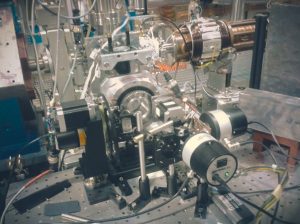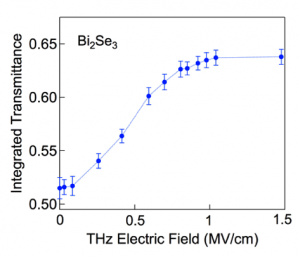 The 2016 Nobel Prize in Physics has been awarded to David Thouless, Duncan Haldane and Michael Kosterlitz for their research on phase transitions in topological insulators.
The 2016 Nobel Prize in Physics has been awarded to David Thouless, Duncan Haldane and Michael Kosterlitz for their research on phase transitions in topological insulators.
These materials, whose electromagnetic and transport properties depend on the exotic topology of their electronic bands, show the important feature of behaving as electric insulators in the bulk, while presenting metallic states at the surface. In addition, theoretical models predict a strong nonlinear optical response of topological insulators to radiation pulses in the THz frequency range of the electromagnetic spectrum. This property, if experimentally confirmed, could pave the way towards the application of topological insulators in ultra-fast THz optics, in the study of non-linear electromagnetic wave (soliton) propagation phenomena and in THz radiation detectors.
Thanks to the SPARC_LAB THz source, the research team coordinated by Stefano Lupi, from the “Sapienza” University in Rome and Enrica Chiadroni from the INFN National Laboratory of Frascati, successfully investigated the non-linear properties of these materials. Results have been recently published on the prestigious journal Nature Communications.
The THz source at SPARC_LAB has the remarkable characteristic of being able to produce electric fields of the order of MV/cm, electric field values peculiar of the atomic limit. Such intense electric fields can, indeed, excite fundamental quantum states of the examined system, allowing optic experiments in the non-linear regime.

Measurements performed at SPARC_LAB with different THz electric fields show that the radiation intensity transmitted by the examined sample (a thin layer of Bi2Se3) is constant for fields up to few tens of kV/cm, where the material has a linear response. As the electric field associated to the THz radiation pulse grows, the transmitted intensity also increases, with an increment of about 25% up to saturation for electric fields higher than 1 MV/cm. An electromagnetic induced transparency in the THz range of the spectrum is the experimental evidence of the non-linear optical behavior of the Topological Insulator Bi2Se3. (Massimo Ferrario)
 INFN-LNF Laboratori Nazionali di Frascati
INFN-LNF Laboratori Nazionali di Frascati